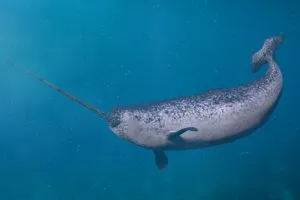Narwhals are iconic marine mammals, often referred to as “unicorns of the sea”. Despite their existence being surrounded by mystery, narwhals are real, living animals which can be observed in the wild.
Narwhals live in the Artic Sea and the Northwest and Northeast Atlantic. They are typically found around northern Greenland, northeastern Canada, Svalbard, and northern Russia. However, as a migratory species, they have also been seen in waters around Germany, the British Isles and the Netherlands.
Keep on reading to understand more about the geographic range of the narwhal and find out more about their summer holidays.
Where Are Narwhals Found?
Narwhals are found in polar areas around the Arctic. The geographic range of narwhals spans three key locations; the Arctic Sea, the Northwest Atlantic, and the Northeast Atlantic. Narwhals are residents of northern Greenland, northeastern Canada, Svalbard, and northern Russian waters1 (source: IUCN).
Narwhals migrate across various areas within their geographic range. For example, narwhals undertake annual (yearly) migrations between the Canada-Greenland region. The duration of their migrations is approximately two months2 (source: Wikipedia).
Vagrant narwhals (individuals spotted in areas where they don’t usually live) have been observed in Germany, the Netherlands, the British Isles, Newfoundland and even as far south as the Alaska Peninsula and Commander Islands3 (source: IUCN).
There is often confusion between the species found in the different polar regions. Narwhals are found in the Arctic, they do not live in Antarctica.
What Is the Narwhals’ Habitat?
Narwhals prefer to live in salt water than freshwater and typically like to live in the polar regions, which are much colder than other oceans.
The habitat of the narwhal can be generally described as the marine oceanic zone and the marine neritic zone.
What is the difference between oceanic and neritic?
The marine oceanic zone is the area of the ocean which is beyond the continental shelf (reaching depths greater than 200 metres) whereas the marine neritic zone is the area of the ocean which is before the drop-off of the continental shelf (generally more shallow areas reaching depths lesser than 200 metres)4 (source: Wikipedia).
Narwhals prefer colder water and are typically found in the northern polar region. However, narwhals are migratory species and their population varies between seasons. Narwhals essentially undertake a “Summer holiday”.
They spend approximately two months in areas (bays and fjords) which are free of ice. In autumn, narwhals move to colder areas: deeper and more offshore areas which are characterised by fast-forming ice5 (source: Wikipedia).
How Far Can a Narwhal Travel?
Narwhals are migratory species.
Some narwhals were tagged by scientists in Scoresby Sound between 2010-2013 in September and August. These narwhals traveled between 22-39km per day at an average speed of 0.1-5.5kph 6 (source: M. P. Heide-Jørgensen, et al, Journal or Zoology, Vol. 297, Issue 1, 2015, pp.54-65).
Narwhals often travel vertically: they regularly undertake deep dives to depths of approximately 1,500 metres (4,500 feet). However, narwhals more often dive to depths of around 800 metres (2,625 feet)7 (source: NOAA).
Where Is the Best Place to See a Live Narwhal?
You cannot see a narwhal live in captivity, so you would have to travel to somewhere where they are known to live in the wild. The best place to see a live narwhal is in its primary location and habitat.
In winter, there is a higher probability of seeing a narwhal in areas which are less than 50% open water. This is because they choose areas which are best for foraging along the seafloor; even in areas of dense pack ice8 (source: IUCN).
Due to logistical reasons, it is more likely for someone to see a live narwhal when they are in shallow coastal areas, rather than in deeper oceanic areas (where they can dive to 1,500 metres [4,500 feet])9 (source: NOAA).
Where Does a Narwhal Spend Most of Its Time?
The daily activity of narwhals is an impressive demonstration of their diving ability. The duration that narwhals spend at different depths often depends on the season.
In summer, narwhals spend most of their time at depths around zero to 50 metres (164 feet). Here they perform more shallow dives at depths around 30 to 300 metres (99 to 990 feet)10 (source: NOAA). The duration of this activity is approximately two months per year11 (source: IUCN).
During part of their migration in the Fall, the depth and duration of their diving activity increase. However, due to their focus on large-scale movement to different areas, they generally perform fewer dives.
In Winter, narwhals spend more of their time in a smaller area, however, here they undertake greater dives. The duration of this activity is typically six months every year. During this period, narwhals spend more than three hours per day at depths below 800 metres (2,625 feet). They also undertake deeper dives to 1,500 metres (2,656 feet) which last approximately 25 minutes each12 (source: NOAA).
Related Questions
Are There Narwhals at the North Pole?
Yes, Narwhals are found at the North Pole. The North Pole is considered a polar region around the Arctic.
Do Narwhals Live in Antarctica?
No, narwhals do not live in Antarctica. They live in the Arctic which is the area surrounding the north pole.
Do Narwhals Live in Canada?
Yes, narwhals do live in Canada, for example around Newfoundland. One of the primary areas which narwhals inhabit is northeastern Canada.
Do Narwhals Live in Iceland?
Yes, narwhals have been found in Iceland.
Do Narwhals Live in Norway?
Yes, narwhals have been found in Norway.
Do Narwhals Live in Australia?
No, narwhals do not live in Australia, they live in the northern hemisphere in the Arctic.


![You are currently viewing Where Are Narwhals Found? [+ How To See Them]](https://polarguidebook.com/wp-content/uploads/2022/12/Where-Narwhals-Live.jpg)


